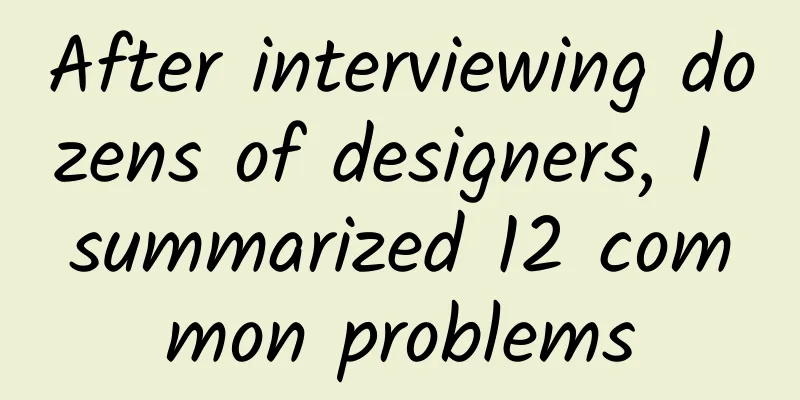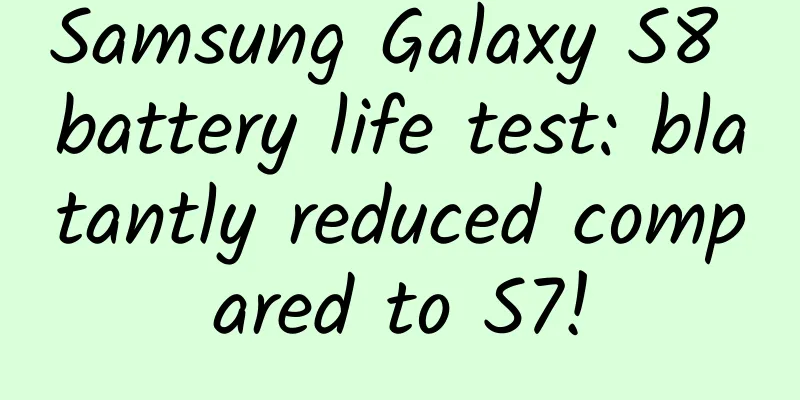After interviewing dozens of designers, I summarized 12 common problems

BackgroundSome time ago, the company was recruiting for junior and mid-level designers. We received a large number of resumes and portfolios. After screening resumes, portfolios, phone interviews, and final design interviews, we finally found the right candidates. During the screening of resumes, portfolios, and phone interviews, I found a lot of problems that bothered most of the new designers who had just entered the industry. The frequency of the same problems was also very high. Today I will share some experience posts with you and complain by the way.
6 Questions to Ask About Your Resume and Portfolio1. Messy layoutAlthough most of the portfolios I received were the same, the layout was acceptable. A few had poor layout, or even no design rules at all. The one that impressed me the most was a visual communication graduate from a relatively good school. Logically, the layout of the visual communication should not be so bad, but due to the lack of understanding of UI portfolios and the lack of care in the production, the whole layout made people doubt whether she really graduated from a visual communication major. My advice to her is to optimize the layout and package her own work. At the same time, pay attention to strengths and avoid weaknesses. Some particularly elementary 3D works do not need to be included in the portfolio, which will give the interviewer the feeling that you are temporarily patchwork. I won’t go into details about typesetting here, but as long as you follow basic design principles, such as alignment, repetition, intimacy, contrast, white space, information classification, etc., you can create a decent portfolio. 2. Pure stacking of imagesNowadays, the competition in the design industry is very fierce. There are many competitors for one position, and the differences between competitors are also very large. Those interviewees who are not serious about making a portfolio are generally eliminated directly in the resume screening and will not enter the next round at all. It is a very common mistake to simply pile up images on your portfolio page. Many people may be too lazy to write some descriptive or analytical text when making a portfolio, so they just pile up all the design drafts on the page and just give it a title. This is meaningless in the eyes of the interviewer, and they will not be interested in continuing to get to know you. Unless you are an illustrator, you can pile up images on the entire page. Therefore, give yourself some time. In addition to designing the interface, also include some thoughts and explanations about page design. This will help the interviewer understand your project and design ideas. 3. Too many wordsIn contrast to a pure stack of pictures, a portfolio contains a lot of text, like a product manual. The interviewer does not have much time to read your copy, so try to combine pictures and texts to briefly explain the key points, otherwise the interviewer will easily lose interest when reading and eventually give up. Simplify your copy as much as possible, reduce the noise of information as much as possible, treat your portfolio as a product you designed, and convey personal information concisely and powerfully. 4. There are many low-level errorsMost of those who make low-level mistakes are designers who have just entered the industry, but there are also some designers who have been working for several years. For example, there is no phone number in the resume or portfolio or the phone number is written incorrectly. For example, many projects have a link to the online effect, but the link is directly merged with the background into a picture and cannot be clicked. Such mistakes are mostly caused by carelessness. Therefore, after the portfolio is completed, be sure to send it to your designer friends around you, or even to people in different industries. After all, everyone has different concerns, and perhaps he can provide you with some constructive suggestions. There is another problem that I believe many designers have encountered. After exporting a portfolio made in Sketch to PDF, they find that phone numbers, links, etc. become garbled characters after copying. This is because the default text in Sketch is Pingfang font, and the embedded text in the generated PDF is not in standard UTF-8 encoding, so it becomes garbled characters when copied. After my own test, in Sketch, important information such as links, phone numbers, names, etc. can be exported using Microsoft YaHei font. The exported information can be copied completely, and even the links can be automatically recognized and opened by directly clicking in the PDF. 5. Too much compression, blurry textGenerally speaking, the problem faced by most designers is how to compress the portfolio to less than 20M. However, when the portfolio is compressed, the overall look and feel of the picture is very poor, the text is blurred, the gradient is layered, and the roughness of the page is aggravated. Therefore, when compressing a portfolio, you must use the correct method, such as compressing some unimportant pictures and shortening the length of the portfolio. In fact, in my opinion, the current network bandwidth and computer performance are sufficient to support the smooth download and opening of portfolios between 50M and 80M. While ensuring the clarity of the page, the quality of the portfolio should be as small as possible. In addition, some companies' email addresses may have restrictions on sending and receiving, and portfolios that exceed a certain quality will be automatically returned. To be on the safe side, when sending your portfolio, also send the address of an online portfolio. I deployed the PDF version of the portfolio to Yuque and sent the link to the interviewer. 6. Too much homogeneityThere are two aspects of homogeneity here, one is homogeneity in content, and the other is homogeneity in form. The first one is difficult to avoid, but the second one can be adjusted freely. First of all, the homogeneity of content is reflected in the fact that most of the portfolios of novices contain many works such as pets, e-commerce, and furniture, and many of them look like drafts at first glance and have not been implemented (of course, it may also be the design routine of the training class), and there are many similarities in the design styles of this type of APP, such as color matching, cards, rounded corners, etc., which are not well distinguished. Of course, if it is an actual project, this cannot be avoided, after all, this is an era where all APPs look more and more alike, but if it is a practice draft, I think we should try our best to avoid such problems. Secondly, the homogeneity in form means that the layout and style of the portfolio have an unspeakable convergence, as if they use or borrow from the same template. As designers, the necessary originality is our foothold. In terms of form, we should try to find new ways as much as possible. We can borrow from others, but we must also have our own style. 6 questions to ask during an interview1. The expression is not fluent and the logic is not strongMany designers have a more introverted personality. They usually keep silent and concentrate on their work. When communicating with others in public, they appear uneasy or incoherent, and their expression ability is poor. How important is communication? Communication is a door to exchange ideas with others. If this door is blocked and not smooth, it will be difficult for you to carry out your work. Therefore, designers need to deliberately practice their ability to express themselves, reduce pauses and catchphrases, and organize and memorize some commonly used words. For example, when introducing yourself, you can organize it into a text and recite it before using it. At the same time, when expressing, designers should explain the cause and effect clearly, pay attention to the logic of expression, and summarize and generalize some general and incomplete concept descriptions, and never just talk about it. 2. The understanding of the problem is not focused enough and the key points are not graspedMany designers have no problem with their ability to express themselves. On the contrary, when a question is raised, they are always very active and fluent in their responses. However, the problem is that if you answer without thinking, it is easy to fall into a misunderstanding of the problem. For open-ended questions, such answers are understandable, but for questions with clear focus, if you keep wandering around the core issue and fail to grasp the key points, your impression score may be lowered. Therefore, after the interviewer asks a question, if you feel you haven't thought it through, you can pause and tell the interviewer: "Wait a moment, I'll think about it before answering." Generally speaking, the interviewer will certainly agree to it, and it will be more reliable to answer after you have thought the question through. 3. Open-ended questions can easily cause panicOpen-ended questions are an important way to examine the breadth of a designer's thinking, but I find that many designers tend to overthink when faced with such questions. There is basically no big deviation in how you answer such questions, and the key lies in your thinking. Therefore, don't panic when you encounter such questions. You can express yourself freely around the topic and show the interviewer your thinking, imagination and personal characteristics. 4. Being too enthusiastic and talkativeOn the contrary to the poor expression, I have also met several designers with superb expression ability. Generally speaking, this is not a big problem, but if things are not done properly, they will go from one extreme to another. For example, when expressing, they talk from beginning to end, and the interviewer can't get a word in at all, and the prepared questions can't be asked one by one due to time constraints. Therefore, when expressing yourself, pay attention to the sense of rhythm and control the timing of the topic. After confirming that you have answered the interviewer's question, you can appropriately indicate that you have finished answering. This will also give the interviewer the opportunity to ask in-depth questions and enhance interaction and communication. 5. Too many divergent and jumpy thoughtsA problem that is highly related to being too enthusiastic is that the thinking is too divergent, and it is easy to turn from a certain question to a large-scale self-expression. For example, when I asked him if he knew C4D, he replied that he knew a little bit, and also knew AE, and could also use AI to draw icons, and by the way, he also talked about some other irrelevant things. In fact, the core point of my question was not this, but the young man was too anxious to express himself, resulting in not answering the core point of the question well. Interview questions are generally closely related to the portfolio, so the portfolio is an introduction and the communication during the interview is the main course. When answering definite questions, don't be in a hurry, take your time. 6. ImpolitenessThis was the most speechless thing that happened during the interview. I thought I was polite and harmless to others, but I couldn't understand why I was treated like this after thinking about it for ten days and ten nights.
Respect others and respect yourself. This should be the principle of being a human being, not the principle of being a designer. Therefore, there is no need to say more. Those who understand will understand. To sum up, these are some of my experiences that I share with you. I hope they will be helpful for you in making your portfolio and interviewing. I wish you all become more and more successful and find a good job. |
Recommend
What is the difference between bidding and SEO, and what is the difference between bidding ranking and natural ranking?
What is the difference between bidding and SEO, a...
Electric Motorcycle News: MG ZS vs Honda XR-V finally surpasses Japanese cars in engine
Speaking of the MG brand, its brother Roewe may b...
How to organize offline activities for learning communities? We offer such a solution
With the rise of knowledge payment , a large numb...
We’ve thought of all the copywriting for brands leveraging the Dragon Boat Festival for you!
June is really a month that makes operations copy...
Zhaoqing SEO Training: How to avoid SEO misunderstandings when optimizing your website?
1. Taboos for modifying the TDK on the homepage S...
Tips for recording notes on Xiaohongshu!
To understand the issue of note collection, just ...
Birds nesting in streetlights? Is this a better or worse life?
This is a street lamp in Shenzhen Futian Mangrove...
App promotion: A summary of domestic and foreign Android application distribution platforms
1. Domestic Android Market 1. Tencent: App Store ...
The 119-year-old special theory of relativity and the 109-year-old general theory of relativity, which one is relative to?
Audit expert: Qian Hang Aerospace science expert ...
How much does it cost to make a Qinhuangdao fast food mini program? What is the quotation for the production of Qinhuangdao fast food mini program?
More and more businesses are paying attention to ...
How many seconds is a femtosecond? Science: The "flying knife" is fast, accurate and ruthless, with a storage life of millions of years!
Laser is called "the fastest knife", &q...
Sad, singer Coco Lee passed away! Can girls who love to laugh also suffer from depression?
Last night, a sad news swept across major social ...
The third batch of astronauts will enter the Tiangong Space Station. How are Chinese astronauts selected?
On May 30, 2023, the successful launch of the She...
How does Baijiahao make money? Teach you how to quickly become a regular account and start benefiting?
Everyone should know that with the rapid developm...









